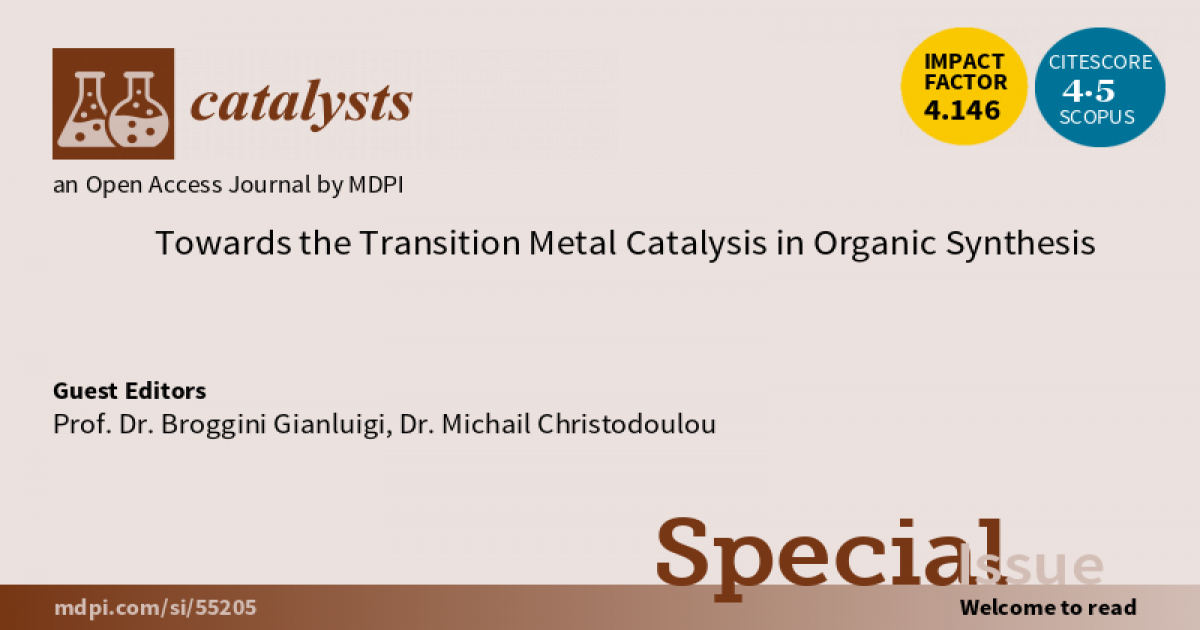Towards the Transition Metal Catalysis in Organic Synthesis
A special issue of Catalysts (ISSN 2073-4344). This special issue belongs to the section "Catalytic Materials".
Deadline for manuscript submissions: closed (31 December 2021) | Viewed by 16990

Special Issue Editors
Interests: methodologies for the synthesis of heterocyclic compounds by transition metal-catalyzed reactions; C–H functionalization processes involving unactivated carbon–carbon multiple bonds
Special Issues, Collections and Topics in MDPI journals
Interests: transition metal catalyzed reactions; synthetic methodologies to obtain bioactive molecules
Special Issues, Collections and Topics in MDPI journals
Special Issue Information
Dear Colleagues,
Transition metal catalyzed reactions have become powerful tools in organic synthesis because allow the formation of carbon-carbon and carbon-heteroatom bonds in mild and sustainable conditions. The synthetic methodologies that are part of the homogeneous catalysis have a considerable interest also from the applicative point of view, as they facilitate access to organic compounds useful in medicinal chemistry and for the production of new materials with high chemo-, regio-, and stereoselectivity.
The broad scope of this Special Issue would include works focused on the development of new synthetic methodologies based on the use of transition metal catalysts and on the preparation of transition metal complexes more performing in the catalysis of organic reactions. In addition, synthetic protocols of industrial interest as well as theoretical studies aimed at shedding light on the mechanism of action of the catalysts are welcome
Prof. Dr. Broggini Gianluigi
Dr. Michail Christodoulou
Guest Editors
Manuscript Submission Information
Manuscripts should be submitted online at www.mdpi.com by registering and logging in to this website. Once you are registered, click here to go to the submission form. Manuscripts can be submitted until the deadline. All submissions that pass pre-check are peer-reviewed. Accepted papers will be published continuously in the journal (as soon as accepted) and will be listed together on the special issue website. Research articles, review articles as well as short communications are invited. For planned papers, a title and short abstract (about 100 words) can be sent to the Editorial Office for announcement on this website.
Submitted manuscripts should not have been published previously, nor be under consideration for publication elsewhere (except conference proceedings papers). All manuscripts are thoroughly refereed through a single-blind peer-review process. A guide for authors and other relevant information for submission of manuscripts is available on the Instructions for Authors page. Catalysts is an international peer-reviewed open access monthly journal published by MDPI.
Please visit the Instructions for Authors page before submitting a manuscript. The Article Processing Charge (APC) for publication in this open access journal is 2200 CHF (Swiss Francs). Submitted papers should be well formatted and use good English. Authors may use MDPI's English editing service prior to publication or during author revisions.
Keywords
- Transition metals
- Homogeneous catalysis
- Organic Synthesis
- Asymmetric reactions
- Reaction mechanism
Benefits of Publishing in a Special Issue
- Ease of navigation: Grouping papers by topic helps scholars navigate broad scope journals more efficiently.
- Greater discoverability: Special Issues support the reach and impact of scientific research. Articles in Special Issues are more discoverable and cited more frequently.
- Expansion of research network: Special Issues facilitate connections among authors, fostering scientific collaborations.
- External promotion: Articles in Special Issues are often promoted through the journal's social media, increasing their visibility.
- e-Book format: Special Issues with more than 10 articles can be published as dedicated e-books, ensuring wide and rapid dissemination.
Further information on MDPI's Special Issue polices can be found here.






